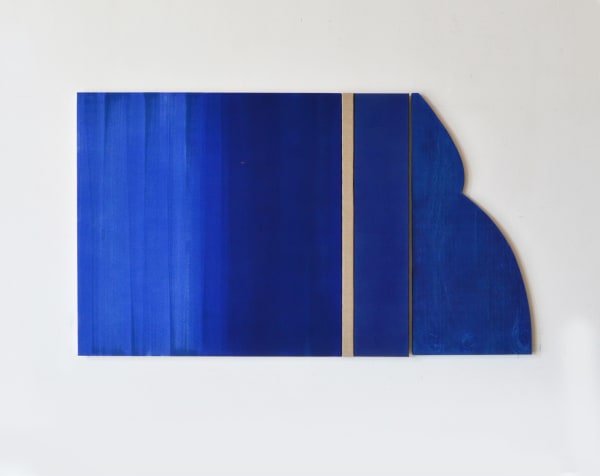Whims, the part and the whole: Quique Sarzamora
"The return of experience through presence is essential."
In Whims, the part and the whole, Quique Sarzamora invites us to inhabit color as experience—a living territory that can only be understood through closeness, through total immersion in the physical presence of the work. His painting is far more than representation; it is a field of action, a space where the visible and the invisible engage in dialogue, where gesture and pigment tell stories of crisis, affection, and healing.
Each canvas is an intimate process, a search for what lies beneath the surface, an exploration of the underground—of that which precedes the creative moment. Sarzamora approaches painting as a language that begins before the first brushstroke, before the contact between brush and canvas. From the preparation of the surface to the vibration of color on the linen, every step is an attempt to unveil what hides within the deepest layers of being.
The result is a body of work that resists being fully captured by a quick glance or photographic reproduction. His fields of color are bold yet full of nuance, demanding us to slow down, to fine-tune our perception, and to pay attention to what only emerges in the shared experience between the canvas and the viewer’s body.
There is no singular narrative in these Whims. Instead, Sarzamora constructs an open space filled with tension between chance and intention, spontaneity and careful planning. Like improvised music, each color finds its place within a fluid composition, where tiny variations—an almost imperceptible tremor on the surface—carry the full weight of what has been lived.
Whims, the part and the whole, is a return to painting as a vital act, a sensory and emotional exploration. The viewer is not a mere observer but an active participant in the work, called to experience the present without filters, to step into color and be transformed by it.
In the words of José Ángel Valente: "It is about arranging these scattered data." Sarzamora does not seek to solve the riddle but rather to build bridges between fragments, between the multiple selves that inhabit us and the countless realities we can imagine. Each canvas is, therefore, a whim in the freest and fullest sense of the word—a desire to dwell in the beauty of the moment, to give shape to chaos, and to invent new worlds through color.
-
 Quique SarzamoraS.T. Políptico. A.L., 2025Handmade oil on linen and wood185 x 115 cm
Quique SarzamoraS.T. Políptico. A.L., 2025Handmade oil on linen and wood185 x 115 cm -
 Quique SarzamoraS.T La parte y el todo, 2025Handmade oil on linen, tablecloth, cotton & paper.165 x 105 cmSeries: Forma Propia
Quique SarzamoraS.T La parte y el todo, 2025Handmade oil on linen, tablecloth, cotton & paper.165 x 105 cmSeries: Forma Propia -
 Quique SarzamoraS.T Azul vertical, 2025Handmade oil on linen120 x 40 cmSeries: Formas Propias
Quique SarzamoraS.T Azul vertical, 2025Handmade oil on linen120 x 40 cmSeries: Formas Propias -
 Quique SarzamoraS.T Amarillo, 2025Handmade oil on linen and paper65,5 x 55 cmSeries: Forma Propia
Quique SarzamoraS.T Amarillo, 2025Handmade oil on linen and paper65,5 x 55 cmSeries: Forma Propia -
 Quique SarzamoraS.T Magenta II, 2025Handmade oil on paper pasted on board65 x 58 cmSeries: Forma Propia
Quique SarzamoraS.T Magenta II, 2025Handmade oil on paper pasted on board65 x 58 cmSeries: Forma Propia -
 Quique SarzamoraS.T Amarillo, 2021Handcrafted oil on linen28 x 22,5 cms
Quique SarzamoraS.T Amarillo, 2021Handcrafted oil on linen28 x 22,5 cms -
 Quique SarzamoraS.T. Políptico Azul I, 2025Handmade oil on linen, wool and wood210 x 120 cmSeries: Formas Propias
Quique SarzamoraS.T. Políptico Azul I, 2025Handmade oil on linen, wool and wood210 x 120 cmSeries: Formas Propias -
 Quique SarzamoraS/T Naranja IV, 2023Handmade oil on linen170 x 120 cm
Quique SarzamoraS/T Naranja IV, 2023Handmade oil on linen170 x 120 cm -
 Quique SarzamoraST Azul, 2024Handcrafted oil on linen170 x 120 cms
Quique SarzamoraST Azul, 2024Handcrafted oil on linen170 x 120 cms
Quique Sarzamora’s Whims, the Part and the Whole
Galería Isolina Arbulu is pleased to present Whims, the Part and the Whole, a solo exhibition by emerging artist Quique Sarzamora. This exhibition invites viewers into a world where painting transcends the visual, becoming an immersive and sensorial experience. Through a masterful interplay of color, materiality, and gesture, Sarzamora redefines painting as a living territory—one where presence and emotion weave an ongoing dialogue between the visible and the invisible.
Sarzamora’s work demands more than observation; it calls for closeness, total immersion, and physical engagement. Each canvas is an intimate process—an exploration of what lies beneath the surface, an investigation into the depths of color and form. His paintings resist quick glances or photographic reproduction, urging viewers to slow down, refine their perception, and participate in the shared space between artwork and observer.
Rather than adhering to a singular narrative, Whims, the Part and the Whole presents a space filled with tension between spontaneity and intention. Sarzamora’s compositions evoke the fluidity of improvisational music, where every hue and subtle variation carries the weight of lived experience. His work is a return to painting as a vital act, an exploration of presence and transformation through color.
Recognized as one of the most promising contemporary artists of his generation, Quique Sarzamora (b. 1992, Seville) has developed a distinctive artistic voice that merges conceptual depth with an interdisciplinary approach. His work has been exhibited in Spain and internationally, earning accolades such as the First Prize in "21 Days at CAC" (2022) and the First Prize in Painting at the Young Emerging Artists Creation Competition (2021). His paintings challenge perception, inviting viewers into a sensory and immersive experience beyond the canvas.
Whims, the Part and the Whole is an invitation to inhabit color, embrace presence, and rediscover the transformative power of painting.
Opening:Friday, 21 March 2025, 18:30hGalería Isolina Arbulu, Marbella, Spain






















